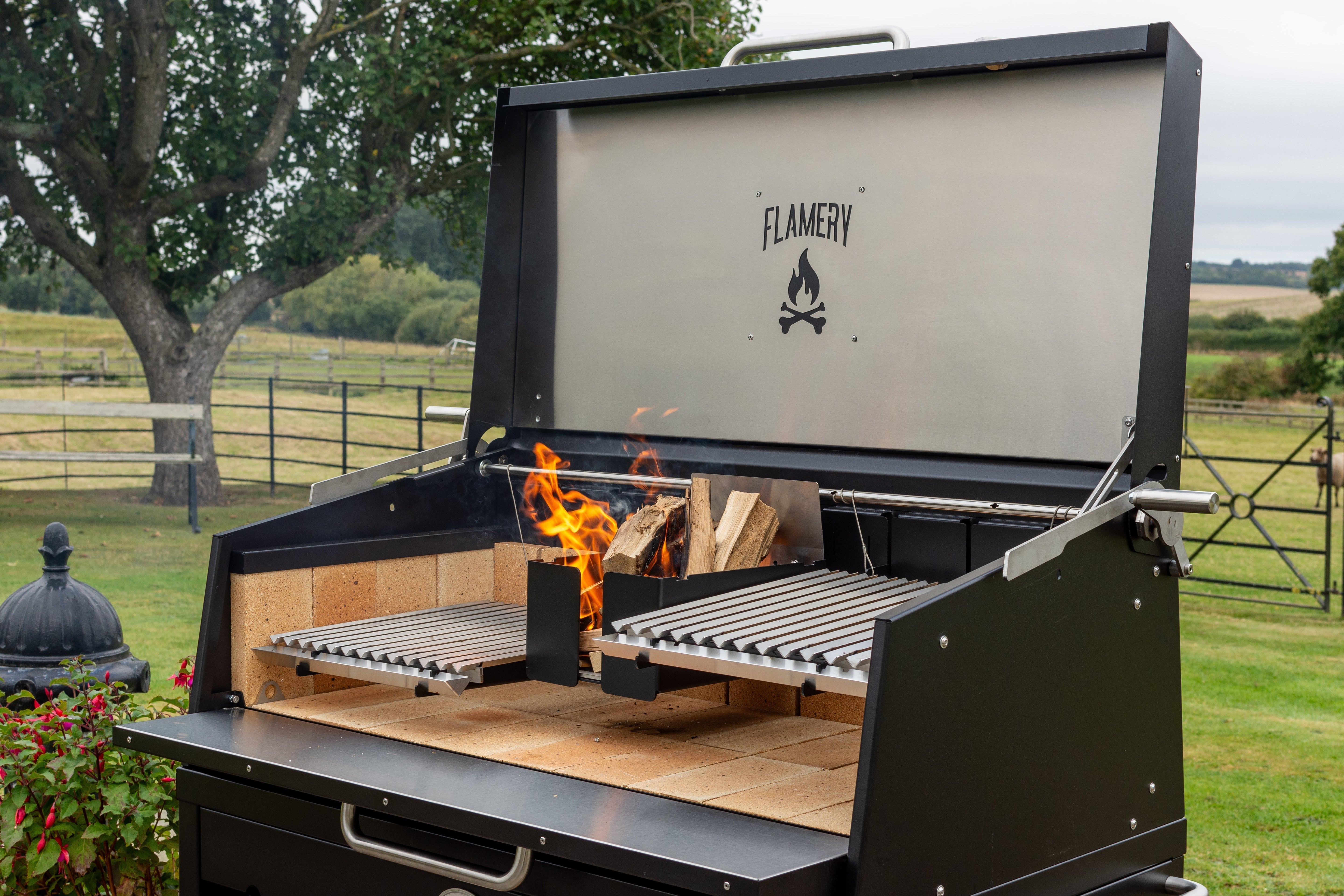When it comes to live-fire cooking, the right grill can make or break the experience. At Flamery, we believe in cooking with real fire—wood, charcoal, smoke, and skill. But while the romance of fire is universal, the way you want to cook with it might not be. That’s where configuration matters.
Whether you're hosting lunches or just want to master a solo tomahawk on a Saturday night, your Asado grill should work with your lifestyle—not against it. So, let’s get into it: what do you really need, and what might just get in your way?
1. Firebox or No Firebox: Is Real Fire Part of the Ritual?
Let’s start with the question we get asked most: do I need a firebox?
It comes down to how you like to cook—and how involved you want to be in the process.
The firebox creates a dedicated space to build and maintain a flame away from your cooking surface. You burn hardwood logs, then rake the glowing embers beneath the grill as needed. This is the traditional Argentine approach - giving you hands-on control over both temperature and flavour.
If you enjoy slow, drawn-out cooking sessions or like to cook multiple things over several hours, a firebox is a game-changer. It means you can continually generate embers while cooking, keeping a consistent, responsive heat going without needing to stop and relight. It’s a more immersive experience - part ritual, part performance.
That said, it does require time, attention, and a bit of patience. If the theatre of fire-building isn’t your thing, or if you’d rather keep things simple, then a firebox might not be the best fit.
Without a firebox, you’ll cook over charcoal. It’s faster to light, easier to manage, and still delivers beautiful live-fire flavour. You lose some of the drama and flexibility, but gain convenience and a cleaner setup.
Verdict:
Go with a Firebox if you want to cook slow, intentional, and immersive.
Go without if you want convenience, cleaner setup, or are just starting out with live-fire.
2. Split Grill or Single Grill: How Do You Actually Cook?
This choice comes down to cooking style, and how much control you want over your fire.

The Split Grill Setup gives you two independently height-adjustable grates, each controlled by its own winch. This allows you to create two distinct cooking zones, ideal for managing different ingredients at different temperatures. Want to keep vegetables gently smoking while you sear steaks over high heat? Or move food off the flame without taking it off the grill entirely? The split setup gives you the flexibility to do it all at once.
It’s the setup for those who like to cook with intention, finesse, or ambition.

The Full Grill, by contrast, has a single winch and one continuous cooking surface. It’s a simpler, more streamlined setup—and depending on your configuration, it can also give you slightly more uninterrupted grill space. That can be a real advantage when you’ve got a crowd to feed.
One often-overlooked feature of the Full Grill is that, while the surface is singular, the grill area is still modular. It’s made up of two separate V-groove panels—meaning you can easily swap out half the surface for a different setup, like space for skewers or a chapa plate. So, while it’s less flexible than the split system in terms of height and heat zones, it’s still adaptable in terms of how you cook.
Verdict:
Choose the Split Grill for dual-zone control, finesse, and flexibility.
Opt for the Full Grill if you favour a cleaner setup, need maximum surface area, or tend to cook one type of dish at a time.
3. Large or Small: How Much Grill Do You Really Need?
This one sounds obvious, but there’s more to it than just “how many people do you cook for?” Size affects more than capacity—it also shapes how you use your grill, how flexible your setup is, and how easily you can move it.

Large Grills: With a cooking surface over 1.1m wide (excluding handles), our large models are designed for serious fire cooking. They’re ideal if you regularly cook for 6+ people, host gatherings, or like to cook multiple dishes at once. A large grill makes reverse-searing, resting zones, and two-zone cooking easier—especially if paired with a split grill setup. But there’s a trade-off. Large grills are heavier, take up more space, and need more fuel to maintain temperature over the whole area.

Small models are more compact (900mm wide without the handles), which makes them better suited to smaller patios or outdoor kitchens where space is tight. They heat up faster, use less fuel, and are easier to handle if you need to move them. But don’t be fooled—these are still serious grills with plenty of capability.
Verdict:
Go Large if you're cooking for a crowd, love to host, or want maximum flexibility across a big surface.
Choose Small if you’re tight on space, prefer quicker setup and cleanup, or if you don’t have to cook for as many people!
4. Freestanding or Built-in: Where Does Your Grill Belong?
This decision isn’t about how you cook, but how your grill fits into your space—and your lifestyle.

Freestanding on Stand
Minimalist, lightweight, and design-forward, the stand option is the cleanest-looking configuration. With its open base and robust legs, it has a sculptural quality—unobtrusive, elegant, and ideal if you want your grill to feel like a piece of furniture, not a fixture.
It’s also the most spacious underneath, it’s easy to sweep under, store extras beside, or even tuck it into a tighter patio layout. If you’re after visual simplicity and a less bulky footprint, this is the choice.

Freestanding on Trolley
If practicality wins the day, the trolley delivers. It’s mounted on castors so you can move your grill around the patio or outdoor kitchen—ideal if you need to store it out of sight when not in use, or in the winter months.
There’s also an opening below, designed for log storage and tool organisation. It adds visual weight and purpose to the grill, making it feel more like a working station. It’s the best option if you want flexibility without sacrificing functionality—or if you simply like having everything within reach.

Built-in
For those who are building (or already have) an outdoor kitchen, the built-in version integrates seamlessly with worktops and cabinetry. It looks polished, permanent, and professional—especially if you’re hosting regularly and want your setup to match.
That said, built-in requires a bit of planning. You’ll need to ensure your space is prepped with the correct cut-out dimensions and enough room for airflow. It’s not something you move around. But if this grill is here to stay, it’s the most refined option.
Verdict:
Choose Stand if you want a lighter, sleeker silhouette with more flexibility in layout.
Go for the Trolley if mobility and built-in wood storage make your life easier.
Opt for Built-in if you're designing around the grill and want it to anchor a purpose-built space.
Final Thoughts: Build Your Setup Around How You Cook
There’s no one-size-fits-all. The best grill is the one that fits your habits, your space, and your appetite. Do you love hosting long lunches with friends? Go big with the firebox, split grills, and a trolley. Want to grill something beautiful for two on a summer evening? A stand-mounted single grill will serve you brilliantly.




Share:
The Konro Has Landed: A New Flame for Focused Cooking
Flamery’s First Show: Grill & Smoke Festival, Malton